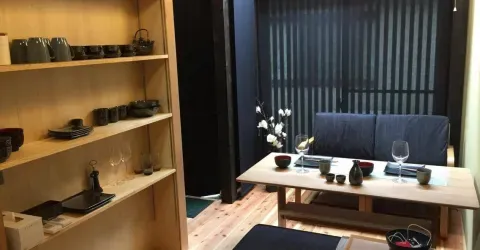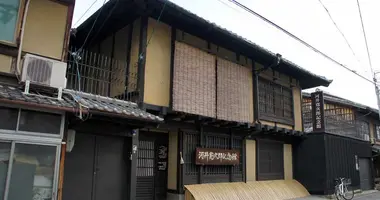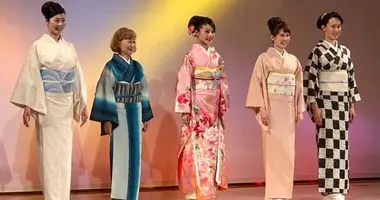Museums in Kyoto
Museums In Kyoto: see a listing of museums in Kyoto including art galleries and private museums.
Kyoto has some of Japan's best and most varied museums. Art, history, science, manga, sake, whisky and traditional crafts are all featured. Some of Kyoto's museums focus on the city's long history, whereas others are new and contemporary.
Kyoto Museums 京都の博物館
- Asahi Beer Oyamazaki Villa Museum of Art
- Bank of Yanagihara Memorial Museum
- Gekkeikan Sake Brewery
- Hakusasonso Hashimoto Kansetsu Museum
- Hosomi Museum
- Imura Art Museum
- Insho Domoto Museum of Fine Arts
- Japan Kanji Museum
- Kawai Kanjiro Memorial Museum
- Koryo Museum of Art
- Kyoto City Library of Historical Documents
- Kyoto Eiga Mura
- Kyoto Eki Museum
- International Manga Museum
- Kyoto City Kyocera Museum of Art (Kyoto Municipal Museum of Art)
- Kyoto Municipal Museum of School History
- Kyoto Museum of Traditional Crafts - Fureaikan
- Kyoto Museum for World Peace
- Kyoto National Museum
- Kyoto Railway Museum
- Kyoto University Museum
- Lake Biwa Canal Museum
- Namikawa Cloisonné Museum of Kyoto
- National Museum of Modern Art Kyoto
- Nishijin Textile Center
- Old Mitsui Family Shimogamo Villa
- Ryozen Museum of History
- Ryukoku Museum
- Sumiya Motenashi Museum
- The Museum of Kyoto
- Yamazaki Whisky Museum
Asahi Beer Oyamazaki Villa Museum of Art
Asahi Beer Oyamazaki Villa Museum of Art exhibits are artworks from the collection of Tamesaburo Yamamoto (1893-1966). Yamamoto was the first president of Asahi Breweries, and an avid collector of Mingei, the Japanese folk art movement of the early twentieth century, as well as modern European art. The Mingei collection is primarily of ceramics, and includes the most well known artists and potters of the movement including Shoji Hamada, Bernard Leach and Kanjiro Kawai.
Bank of Yanagihara Memorial Museum
The Bank of Yanagihara Memorial Museum, close to Kyoto Station, is a restored Meiji Period wooden bank building dating from 1907. Inside are exhibits relating to Japan's outcaste community, the Burakumin or Dowa. There are original photographs, documents, maps and video displays as well as tools related to leather work, traditionally carried out by the community.
Gekkeikan Sake Brewery
Gekkeikan Sake Brewery is located not far from Fushimi Inari Shrine. The complex of buildings is fascinating and sake tasting is available. Sake brewing has a long history in the Fushimi area. There are over 6,000 tools and implements related to sake brewing and production at the Gekkeikan Sake Brewery.
Hakusasonso Hashimoto Kansetsu Garden & Museum
Hakusasonso Hashimoto Kansetsu Garden & Museum is the former home, studio and garden of Hashimoto Kansetsu (1883-1945), a distinguished painter of the Taisho and Showa eras in the nihonga style. Hashimoto was born in Kobe but made his home in Kyoto. The property is the largest artist's residence in Japan.
Hosomi Museum
Hosomi Museum is the collection of the Hosomi family, for which it is named, and features a wide range of Japanese pieces of almost every genre with pieces on display from the Yayoi Period to the Edo Period (1603-1867). The Hosomi Museum is located on the western edge of the Okazaki museum district.
Imura Art Museum
Imura Art Museum, near Demachiyanagi Station and Shimogamo Shrine, has an exquisite collection of antique French glassware, including pieces produced by baccarat and Daum, as well as 50 pieces of Japanese ceramics including kakiemon - porcelain with an overglaze decoration - from Arita, nabeshima ware by Imaemon as well as Imari ware dating back to the Edo Period.
Insho Domoto Museum of Fine Arts
Insho Domoto Museum of Fine Arts is a quirky facility across the road from Ritsumeikan University not far from the Golden Pavilion and Ryoanji Temple. The museum features the art of Kyoto-born Insho Domoto (1891-1975), who was a great Nihonga painter.
Japan Kanji Museum & Library
Japan Kanji Museum & Library in Gion opened in 2016 and has fun and interactive displays on the history and development of kanji in Japan. Test your kanji skill and knowledge!
Kawai Kanjiro Memorial Museum
Kawai Kanjiro Memorial Museum is the former home and studio of the famous master potter and craftsman. The preserved, traditional house and garden contains the potter's kiln and many works from his illustrious career.
Koryo Museum of Art
The Koryo Museum of Art is an interesting museum dedicated to Korean art in the north west of Kyoto. The museum was established by businessman Jeong Jo-mun, a first generation Korean-Japanese, who grew up in Kyoto after first arriving as a young child in 1924. The collection grew until his house was converted into the museum in 1988.
Kyoto City Library of Historical Documents
Kyoto City Library of Historical Documents is a vast resource of documents and books relating to the history of Kyoto and is open to scholars and interested visitors.
Kyoto Eiga Mura
Kyoto Eiga Mura is a theme park located on the grounds of a still working film studio. You can wander among the ghosts of Kurosawa and Mizoguchi as you watch sword-fighting performances and unleash your inner samurai.
Kyoto Eki Museum
Kyoto Eki Museum is on the 7th floor of the Kyoto Station building and is part of the Isetan Department Store, holding regular exhibitions of both western and Japanese art.
Kyoto International Manga Museum
Kyoto International Manga Museum is the only museum in Japan devoted entirely to manga. The Kyoto International Manga Museum has quickly become one of the most popular museums in Kyoto for foreign visitors.
Kyoto Municipal Museum
Kyoto City Kyocera Museum of Art (formerly Kyoto Municipal Museum of Art) is a massive old structure that has a fine collection of Japanese works. It also gets a block buster show once a year. The Kyoto City Kyocera Museum of Art is located in the Ozakai museum district and reopened under its new name in 2020.
Kyoto Municipal Museum of School History
Kyoto Municipal Museum of School History is housed in a former school in Gion and introduces all aspects of Japanese school education from the end of the Edo Period to the present day.
Kyoto Museum of Traditional Crafts - Fureaikan
Kyoto Museum of Traditional Crafts - Fureaikan is located in the basement of Miyako Messe and showcases over 500 traditional crafts in over 70 categories. The theme of this excellent, free museum is "beauty of use" seen in traditional Japanese crafts such as kimono, lacquer ware and ceramics.
Kyoto Museum for World Peace
Kyoto Museum for World Peace is one of several peace museums in Japan. It takes a refreshingly harsh look at Japan's wartime behavior. The museum is located just outside of the Kinugasa campus of Kyoto's Ritsumeikan University.
Kyoto National Museum
Kyoto National Museum is located across from Sanjusangendo. It house artifacts from Kyoto's temples and shrines and now houses over 2,000 Japanese artifacts from prehistoric times up to the modern era.
Kyoto Railway Museum
Kyoto Railway Museum in Umekoji Park near Kyoto Station is now the largest railway museum in Japan and opened in 2016. Inside the museum are trains on display from the steam age to the shinkansen with lots of interactive exhibits, rides and model trains as well.
Kyoto University Museum
Kyoto University Museum (KUM) is the oldest university museum in Japan and has a valuable, eclectic collection spanning humanities, natural history and engineering. The diverse nature of the exhibits reflects the differing research work of professors at various faculties of the university.
Lake Biwa Canal Museum
The Lake Biwa Canal Museum tells the history of the canal that brings water to Kyoto from Japan's largest lake, Lake Biwa, twenty kilometers away. The museum is free and is located close to Nanzenji Temple.
Namikawa Cloisonné Museum of Kyoto
The Namikawa Cloisonné Museum of Kyoto in the Okazaki district of Kyoto is the preserved home, studio and garden of cloisonné master Namikawa Yasuyuki (1845-1927) and was built in 1894. The museum includes the artist's studio and kiln, with the tools of his trade also on display along with 130 pieces of his exquisite craft.
National Museum of Modern Art, Kyoto
National Museum of Modern Art, Kyoto is in Okazaki, Kyoto's museum area. Fumihiko Maki's structure alone is worth a visit and the grand, spacious interior is a popular place to relax and admire the Lake Biwa Canal or dine in the museum's restaurant.
Nishijin Textile Center
Nishijin Textile Center in west Kyoto is a museum, a factory, a shop and a gallery all in one, dedicated to the art of the Japanese kimono and obi.
Old Mitsui Family Shimogamo Villa
The Old Mitsui Family Shimogamo Villa just south of the entrance to Shimogamo Shrine was the former Kyoto rest house for the wealthy, Mitsui family who controlled the Mitsui business empire in the pre-World War II period. The refined Taisho-era residence is surrounded by a moss-covered strolling garden with pond and tea house.
Ryozen Museum of History
The Ryozen Museum of History is dedicated to the often violent events that brought to an end the Tokugawa regime at the climax of the Edo Period (1603-1868). The museum shop has a variety of sought-after goods such as Sakamoto Ryoma t-shirts and Shinsengumi-related items.
Ryukoku Museum
Ryukoku Museum opened in 2011 opposite Nishi Honganji Temple and is dedicated to Buddhist art detailing the spread of Buddhist culture and belief from its birthplace in the Ganges valley in India, through South East Asia, China and Korea to Japan. The exterior of the museum features a huge blind made of ceramics.
Sumiya Motenashi Museum
Sumiya Motenashi Museum is the last remaining "ageya" in Japan. It was once a high-end restaurant and brothel in one of Kyoto's red-light districts - Shimabara - in the west of the city. Ageya were elegant restaurants where Geisha and Tayu performed and lived. Performances included elaborate tea ceremonies, songs and dances. Sumiya has been owned and managed by the Nakagawa family since 1641 and the present enlarged buildings date from 1787.
The Museum of Kyoto
The Museum of Kyoto is a brick Meiji Era building in the center of Kyoto on Sanjo Dori. It has a good collection of objects related to Kyoto. The Museum of Kyoto opened in 1988 and covers the lengthy history of Kyoto and has regular rotating exhibits. There are three sections to the permanent collection: an art gallery with both western and Japanese paintings as well as a collection of Japanese arts and crafts including Kyoto dolls (kyoningyo); an historical section and a hall for films about Kyoto.
The Yamazaki Whisky Museum
The Yamazaki Whisky Museum is at the Suntory Yamazaki Distillery. Founded in 1923, this is Japan's first commercial distillery and, along with several breweries, was built in Yamazaki to take advantage of the quality of the local water. It was founded by Shinjiro Torii, and the company later was named Suntory. The museum has two floors of exhibition space as well as a shop and a tasting counter. There is no entry fee but reservations are mandatory. On the first floor are displays chronicling the history of Suntory and it's founder.
See another listing of museums in Kyoto.
Related Japan Museum Articles
What's On Now in Kyoto and Tokyo
Tokyo Museums
Nagoya Museums
Nagoya Castle Museum
Osaka Museums




























































